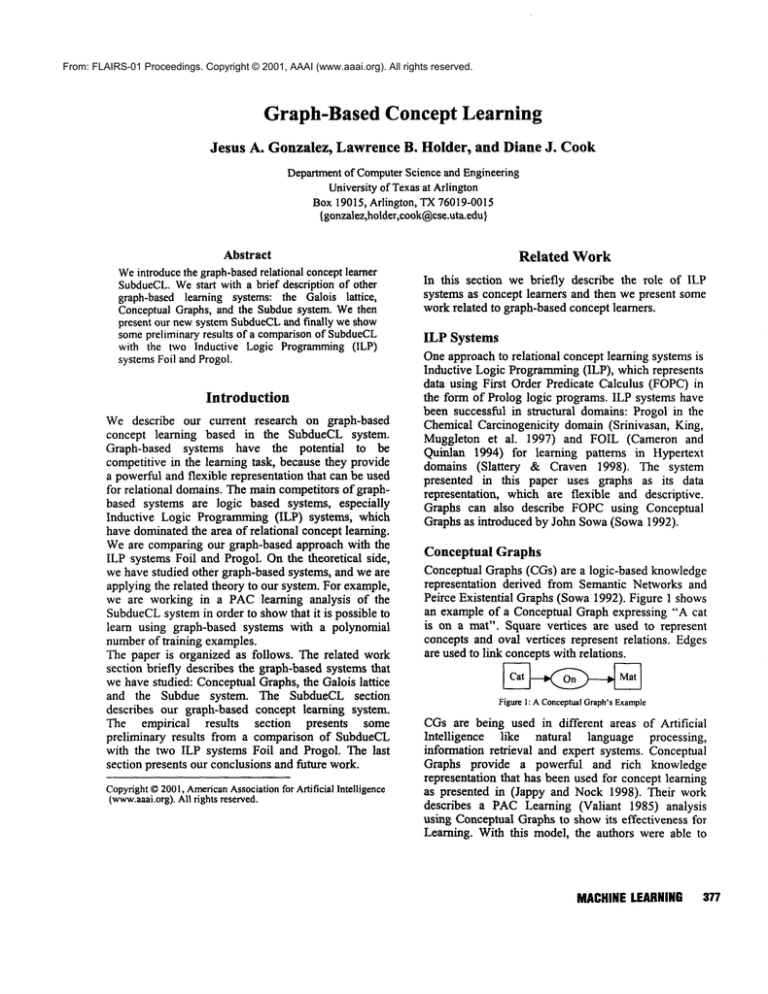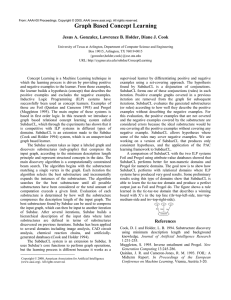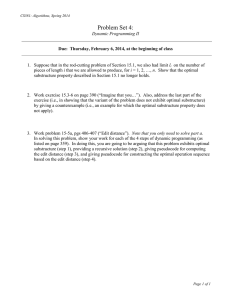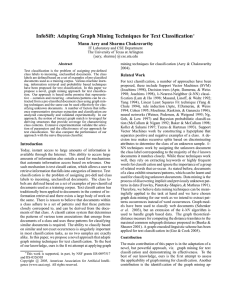
From: FLAIRS-01 Proceedings. Copyright © 2001, AAAI (www.aaai.org). All rights reserved.
Graph-Based Concept Learning
Jesus A. Gonzalez,
Lawrence B. Holder,
and Diane J. Cook
Departmentof ComputerScience and Engineering
Universityof Texasat Arlington
Box 19015, Arlington, TX76019-0015
{ gonzalez,holder,cook@cse.uta.edu
}
Abstract
Weintroducethe graph-basedrelational conceptlearner
SubdueCL.
Westart with a brief description of other
graph-based learning systems: the Galois lattice,
Conceptual Graphs, and the Subduesystem. Wethen
prcsent
ournewsystem
SubdueCL
andfinally
weshow
somepreliminary
results
ofa comparison
ofSubducCL
withthetwoInductive
LogicProgramming
(ILP)
systems
Foil
andProgol.
Introduction
Wedescribe our current research on graph-based
concept learning based in the SubdueCLsystem.
Graph-based systems have the potential
to be
competitive in the learning task, because they provide
a powerful and flexible representation that can be used
for relational domains. The main competitors of graphbased systems are logic based systems, especially
Inductive Logic Programming (ILP) systems, which
have dominatedthe area of relational concept learning.
Weare comparing our graph-based approach with the
ILP systems Foil and Progol. On the theoretical side,
we have studied other graph-based systems, and we are
applying the related theory to our system. For example,
we are working in a PAClearning analysis of the
SubdueCL
system in order to showthat it is possible to
learn using graph-based systems with a polynomial
numberof training examples.
The paper is organized as follows. The related work
section briefly describes the graph-based systems that
we have studied: Conceptual Graphs, the Galois lattice
and the Subdue system. The SubdueCL section
describes our graph-based concept learning system.
The empirical results
section presents some
preliminary results from a comparison of SubdueCL
with the two ILP systems Foil and Progol. The last
section presents our conclusions and future work.
Copyright
©2001,American
Association
for Artificial Intelligence
(www.aaai.org).
Allrights
reserved.
Related
Work
In this section we briefly describe the role of ILP
systems as concept learners and then we present some
work related to graph-basedconcept learners.
ILP Systems
One approach to relational concept learning systems is
Inductive Logic Programming(ILP), which represents
data using First Order Predicate Calculus (FOPC)
the form of Prolog logic programs. ILP systems have
beensuccessful
instructural
domains:
Progol
in the
Chemical
Carcinogenicity
domain(Srinivasan,
King,
Muggletonet al. 1997) and FOIL (Cameronand
Quinlan1994)for learning
patterns
in Hypcrtext
domains(Slattcry& Craven1998).The system
presented
in thispaperusesgraphsas its data
representation,
whichareflexible
anddescriptive.
Graphscan alsodescribeFOPCusingConceptual
Graphsas introduced
by JohnSowa(Sowa1992).
Conceptual Graphs
Conceptual Graphs (CGs) are a logic-based knowledge
representation derived from Semantic Networks and
Peirce Existential Graphs (Sowa1992). Figure 1 shows
an example of a Conceptual Graph expressing "A cat
is on a mat". Square vertices are used to represent
concepts and oval vertices represent relations. Edges
are used to link conceptswith relations.
Figure 1: A Conceptual Graph’s Example
CGsare being used in different areas of Artificial
Intelligence
like natural language processing,
information retrieval and expert systems. Conceptual
Graphs provide a powerful and rich knowledge
representation that has been used for concept learning
as presented in (Jalopy and Nock 1998). Their work
describes a PACLearning (Valiant 1985) analysis
using Conceptual Graphs to showits effectiveness for
Learning. With this model, the authors were able to
MACHINELEARNING 377
prove that it is possible to PAClearn Conceptual
Graphsfor a restricted class that consists of Conceptual
Graphs with at most n vertices. Fromthat result they
stated the theorem:
"Let Cca,)~ CG denote a conceptual graph
class. If both [Cta,) [ and the complexity of the
projection test between elements of Cta,) are
polynomial in (o~i),
then Cea~) is PAC
learnable".
Where a i (a~,a2,
and a3) are the richness
parameters that define the search space of the class of
conceptual graphs and correspond to the number of
relations, concepts and labels that are available to form
valid conceptual graphs. The projection
test
corresponds to the test used to verify if an example
belongs to a class or not (a form of graph morphism).
Galois Lattice
Another technique used to accomplish the task of
concept learning using a graph representation is drawn
from the frameworkof a Galois Lattice (Liquiere and
Sallantin 1998). In the Galois Lattice frameworkfor
learning, each node in the lattice consists of a
description graph and the set of examplesdescribed by
the graph. The lattice construction starts with an empty
lattice. In the first step, the description of all the
examplesis added to the lattice. For the rest of the
levels, new concepts are created from each pair of
concepts that have already been found in the previous
step. The operation used to create a concept from two
other concepts is called generalization "^" and given
two description
graphs, produces the largest
description graph that is contained in both original
graphs. After a new concept is created, the examples
that it describes are associated with it (the unionof the
examplesassociated to its parent graphs).
The search space for the Galois Lattice algorithm
consists of all the possible generalizations of the set of
training examples. In this case, the learning process
goes from specific to general. The complexity of the
Galois Lattice creation algorithm is O(n3p)(Liquiere
and Sallantin 1998), where n is the number of
examplesand p is the size of the lattice. Liquiere and
Sallantin mentioned that they had an experimental
implementation called GRAAL,
but that it could not be
used in practical cases yet and that it was only an
algorithm used for formal analysis. The Galois Lattice
methodis restricted to be used only with the subclass
of Locally Injective Graphs (LIGs), because it was
proved that the generalization operation runs in
polynomial time for these types of graphs. If a
different methodto create the Galois Lattice (that does
378
FLAIRS-2001
not use this generalization operation) is used, the
restricted classes (in this case LIG’s) might
different. In the future work of the Galois Lattice
research, the authors mentioned that they would work
to prove that LIG is PAClearnable. They also hope to
make GRAALa tool to work with practical
applications.
Subdue
Subdue (Cook, Holder 1994 ) is a Data Mining tool
that achieves the task of clustering using an algorithm
categorized as an example-based and relational
learning method.It is a general tool that can be applied
to any domain that can be represented as a graph.
Subduehas been successfully used on several domains
like CADcircuit analysis,
chemical compound
analysis, and scene analysis (Cook, Holder and Djoko
1996, Cook, Holder and Djoko 1995, Cook and Holder
1994, and Djoko, Cookand Holder 1995).
Subdue uses a model evaluation method called
"Minimum
Encoding" that is a technique derived from
the minimumdescription length principle (Rissanen
1989) and chooses as best substructures those that
minimize the description length metric that is the
length in numberof bits of the graph representation.
The numberof bits is calculated based on the size of
the adjacency matrix representation of the graph.
Accordingto this, the best substructure is the one that
minimizes I(S) + I(GIS), where I(S) is the number
bits required to describe substructure S, and I(GIS)
the numberof bits required to describe graph G after
being compressedby substructure S.
The main discovery algorithm is a computationally
constrained beam search. The algorithm begins with
the substructure matchinga single vertex in the graph.
Each iteration
the algorithm selects the best
substructure and incrementally expands the instances
of the substructure. The algorithmsearches for the best
substructure until all possible substructures have been
considered or the total amountof computationexceeds
a given limit. Evaluation of each substructure is
determined by howwell the substructure compresses
the input graph according to the heuristic being used.
The best substructure found by Subduecan be used to
compress the input graph, which can then be input to
another iteration of Subdue. After several iterations,
Subduebuilds a hierarchical description of the input
data where later substructures are defined in terms of
substructures discovered on previous iterations.
Figure 2 shows a simple example of Subdue’s
operation. Subduefinds four instances of the triangleon-square substructure in the geometric figure. The
graph representation used to describe the substructure,
as well as the input graph, is shownin the middle.
Vertices:
objects
or attributes
Edges:relationships
4 instances of
t__.J
Figure 1: SUBDUE’S
Example.
SubdueCL
As we mentionedbefore, first-order logic can also be
representedas a graph, and in fact, first-order logic is a
subset of what can be represented using graphs (Sowa
1992). Therefore, learning systems using graphical
representations have the potential to learn richer
concepts if they can handle the increased size of the
hypothesis space. The Subdue Concept Learner (which
we will refer to as SubdueCL)is an extension to the
Subdue system described before. The main challenge
in adding concept-learning capabilities to Subduewas
the inclusion of "negative" examplesinto the process.
Substructures that describe the positive examples; but
not negative examples,are likely to represent the target
concept. Therefore, the Subdueconcept learner accepts
both positive and negative examplesin graph format.
Since SubdueCLis an extension to Subdue, it uses
Subdue’s core functions to perform graph operations,
but the learning process is different. SubdueCLworks
as a supervised learner by differentiating positive and
negative examples using a set-covering approach
instead of graph compression. The hypothesis found by
SubdueCL consists of a set of disjunctions
of
conjunctions (substructures), i.e., the concept may
contain several rules. SubdueCLforms one of these
conjunctions (rules) in each iteration. Positive example
graphs that are described by the substructure found in a
previous iteration are removed from the graph for
subsequentiterations.
The way in which SubdueCL decides
if the
substructures (or rules) will be part of the concept
not is also different from Subdue. SubdueCLuses an
evaluation formula to give a value to all the generated
substructures.
Thisformulaassignsa valueto a
substructure
according
to howwellit describes
the
positiveexamples(or a subsetof the positive
examples)
without
describing
thenegative
examples.
Thcn,positive
examples
covered
by thesubstructure
increasethe substructure
valuewhilenegative
examples
decrease
its value.In thisformulathe
positive
examples
thatarenotcovered
andthenegative
examples
covered
by thesubstructure
areconsidered
errorsbecause
theidealsubstructure
wouldbe one
covering
allthepositive
examples
without
covering
any negativeexample.The substructure
valucis
calculated
asfollows:
value = 1 - Error
Error = # PosEgsNotCovered +# NegEgsCovered
# PosEgs+# NegEgs
Using this formula, SubdueCLchooses rules that
maximizethe substructure’s value and in this way it
minimizes the number of errors made by the
substructures used to form the concept.
Wehave two versions of SubducCL. The first is an
inconsistent
learner,
which means that the
substructures of the hypothesis are allowed to cover
some negative examples. The second vcrsion is a
consistent learner, in whichthe substructures that form
the hypothesis are not allowed to cover any negative
example.
SubdueCL’s Algorithm
The SubducCLalgorithm is shown in figure 3. The
main function takes as parameters the positive
examples Gp, the negative examples G,, the Beam
length (since SubdueCL’ssearch algorithm is a beam
search) and a Limit on the numberof substructures to
include in its search. The main function makescalls to
the SubdueCLfunction in order to form the hypothesis
H that describes the positive examples. A substructure
is added to H each time that the SubdueCLfunction is
called. In case that the SubdueCLreturns NULL,the
Beamis increased so that a larger search space can be
explored during SubdueCL’s search. Also, after
SubdueCLfinds a substructure, the positive examples
covered by it are removedfrom the positive graph.
Main(Gp,
Gn,Limit, Beam)
H={}
Repeat
Repeat
BestSub= SubdueCL(Gp,
Gn,Limit, Beam)
If BestSub
= {}
ThenBeam= Beam* 1.1
Until( BestSub
#: {})
Gp= Gp- { p ¯ GpI BestSub
coversp }
H = H + BestSub
UntilGp= { }
ReturnH
End
Figure 3: SubdueCL’s Main Function
Figure 4 shows the SubdueCLfunction, which starts
building a ParentList creating a substructure for each
vertex in the graph with a different label but keeping
only as manysubstructures as the length of the Beam
The "raod Beam"qualifier means that the lists keep
only as manysubstructures as the Beamsize. Each of
MACHINELEARNING 379
those substructures in the parent list is then expanded
by one vertex or one vertex and an edge in all possible
ways and evaluated according to the formula presented
before. Those substructures that cover at least one
positive exampleare kept in the BestList but limited to
the Beamsize. A ChildList keeps all the substructures
that were obtained from the expansion of the
substructures in the ParentList and is also limited by
the Beamsize. The Limit parameter is used to expand
as manysubstructures as the Limit, but if the BestList
is empty after expanding Limit substructures from the
ParentList, the limit is increased until one is found.
The SubdueCLfunction returns the BestList containing
all the substructures that at least cover one positive
example.It is importantto mentionthat all the lists are
ordered according to the substructures values. The only
variation of the Consistent version of the SubdueCL
algorithm is that it only considers substructures
covering no negative examplesin the BestList.
SubdueCL(Gp,Gn, Limit, Beam)
ParentList = (All substructures of one vertex) roodBeam
Repeat
BestList= { I
Exhausted = FALSE
While( (Limit> 0 ) or (ParentList~e{})
ChildList = {}
Foreaehsubstueture in ParentList
C = Expand(Subslrueture)
BestList = ( BestList u CoverPos(C)) rood
ChildList = ( ChildList u C ) rood Beam
Limit = Limit - 1
EndFor
ParentList
= ChildListroodBeam
EndWhile
IfBestList
= {}
ThenExhausted= TRUE
ElseLimit= Limit* 1.2
Until( ( BestList
~e{}) or ( exhausted
= TRUE
Return
first(BestList)
End
Figure4: SubdueCL
Function
Learning with Graphs
Although the search space that SubdueCLconsiders to
learn from graphs is exponential, empirical results
show that it is able to learn without exhaustively
reviewing it. Empirical experiments in the following
section show this. Weare working in a PACLearning
analysis of SubdueCLto support this statement. Using
graphs as the knowledgerepresentation for learning
has several advantages, among them we have that
graphs are a very expressive and comprehensible
representation.
Another advantage is that the
hypothesis space consists of connected graphs,
SubdueCLsearches using the relations that connect
concepts, this makes SubdueCL’sapproach good for
both non-relational and relational domains.
380
FLAIRS-2001
Empirical Results
Weare now in the testing phase of our graph-hased
concept learner, and as part of those tests we are
comparing it with the two ILP systems FOIL and
Progol. Until nowwe have tested it in five domainsbut
we will continue with more and different types of
domains. Five non-relational domains were used to
compare FOIL, Progol and SubdueCL: golf, vote,
diabetes, credit, and Tic-Tac-Toe.The golf domainis a
trivial domain used to demonstrate machinelearning
concepts, typically decision-tree induction (Quinlan
1986). The vote domain is the Congressional Voting
Records Database available from the UCI machine
learning repository (Keoghet. al 1998). The diabetes
domainis the Pima Indians Diabetes Database, and the
credit domain is the GermanCredit Dataset from the
Staflog Project Databases (Keogh et. AI 1998). The
Tic-Tac-Toe domain consists of 958 exhaustively
generated examples. Positive examplesare those where
"X" starts moving and wins the game and negative
examples are those where "X" looses or the game is
fled. The examplesare represented by the position on
the board and the value for that position. Therefore the
possible values for each position are either "X" or
"O". The three systems were able to learn the concept
correctly, that is; they learned the eight configurations
where "X" wins the game. Table 1 shows the percent
accuracy results on the non-relational domains. The
results show that SubdueCLis competitive with Foil
and Progol in these types of domains.
Table1: Percentaccuracyresults on non-relationaldomains
POlL
Progol
SubdueCL
Uolf
60.67
33.33
66.67
Vote
93.U2
76.9~
94.~B
Diabetes
70.66
51.97
64.21
Credit
66.16
44.55
71.52
TTT
IOU.UU
lOO.OO
100.00
As for relational domains we are working with the
chess, and carcinogenesis domains. The Chess domain
consists of 20,000 examples of row-columnpositions
for a white king, white rook and black king such that
the black king is in check (positive) or not (negative).
co)
Figure 5. Anexamplefrom the chess domain. (a) Board
configurationand (b) SubdueCL’s
graphical representation
of the example.
Therefore, if white’s turn is next, then the positive
examplesare illegal configurations. Figure 5b shows
Subdue’s representation for the chess domainexample
in figure 5a. Figure 6 shows two substructures found
by SucdueCL in the chess domain. Each piece is
represented by two vertices corresponding to the row
and column of the piece, connected by a position
relation (e.g., WKC
stands for white king column).
Results in the Chess domain show 97% accuracy for
SubdueCL,99%for FOIL, and 86%for Progol. Due to
computational constraints
only a subset (5000
examples) of the entire database was used for the 10
fold cross validation. The accuracy results are 99.74%
for Progol, 99.34% for FOIL, and 99.74% for
SubdueCL.In terms of numberof rules, Progol learned
5 rules, FOILlearned 11 rules, and Subduelearned 7
rules (substructures).
Figure 6. Twoof eleven substructures found by SubdueCL
in the chess domain.
/
Figure 7. Twoof the substructures foundby SubdueCL
in
the cancer domain.
The carcinogenesis
database is composed of
information about chemical compoundsand the results
of laboratory tests made to rodents in order to
determine if the chemical induces cancer to them or
not. The information used for this experiment was
taken
from
the
web
site:
ht_~://web.comlab.ox.ac.uk/oucl/research/areas/machle
arn/PTE/. This database was built for a challenge to
predict the result of the tests using machine-learning
techniques. The dataset contains 162 positive examples
and 136 negative examples. Figure 7 shows two
substructures
found by SubdueCL in preliminary
results in the cancer domain. The first substructure
says that a compound that has a positive
"drosophila_slrl"
test causes cancer. The second
substructure says that a compoundthat has a positive
"chromaberr" test and also has an "amine" group
causes cancer.
Conclusions
Wehave described three approaches to graph-based
concept learning: conceptual graphs, the Galois lattice,
and SubdueCL. Preliminary theoretical
analyses
indicate that a constrained version of SubdueCLmay
PAClearn, but more analysis is necessary. Empirical
results indicate that SubdueCLis competitive with the
ILP systems FOILand Progol. Therefore, graph-based
relational concept learning is competitive with, and
potentially
more expressive than logic-based
approaches. Future experimentation will compare the
two approaches on controlled artificial domains, the
cancer domain, and graph representations of the web,
where we can learn hyperlink-based relational concepts
distinguishing two sets of webpages.
References
Cameron,R. M. and Quinlan, J. R. Efficient top-down
inductionof logic programs.SIGART,
5(1):33-42, 1994.
Cook,D. J.; Holder, L. B. Substructure discovery using
minimumdescription length and backgroundknowledge.
Journalof Artificial IntelligenceResearch,1:231-255,1994.
Cook, D. J.; Holder, L. B.; and Djoko, S. "Knowledge
DiscoveryfromStructural Data," Journal of Intelligence and
InformationSciences, Vol. 5, Number
3, pp. 229-245,1995.
Cook,D. J.; Holder,L. B.; and Djoko,S. Scalablediscovery
of informativestructural conceptsusing domainknowledge.
IEEEExpert,11 (5):59-68,1996.
Jappy. and Nook,"PACLearning ConceptualGraphs," Int.
Conference
in ConceptualStructures, pp. 303- 318, 1998.
Keogh,E.; Blake, C.; and Merz, C. J. UCIrepository of
machinelearning databases, 1998.
Liquiere, M. and Sallantin, J. "Structural MachineLearning
with Gaiois Lattice and Graphs," Proceedings of the
Fifteenth Intemational Conferencein MachineLearning,
MorganKanfmann,pp. 305-13, 1998.
Muggleton, S. Inverse entailment and Progol. New
GenerationComputing,13:245-286,1995.
Quinlan,J. R. Inductionof decisiontrees. Machine
Learning,
1(1):81-106,1986.
Rissanen,J. Stochastic Complexityin Statistical Inquiry,
WorldScientific PublishingCompany,
1989.
Sowa,J., "Conceptualgraphs summary,"Current Research
and Practice, chapter1, pp 3-52, Ellis Horwood,
1992.
Srinivasan; Muggleton;King;and Steinberg, "Mutagenesis:
ILPExperimentsin a Non-Determinate
Biological Domain,"
Proceedings of the Fourth Inductive Logic Programming
Workshop,1994.
Valiant, L. "Learning Disjunction of Conjunctions,"
International Joint Conference
on Artificial Intelligence pp.
560 - 566, 1985.
MACHINE
LEARNING381







